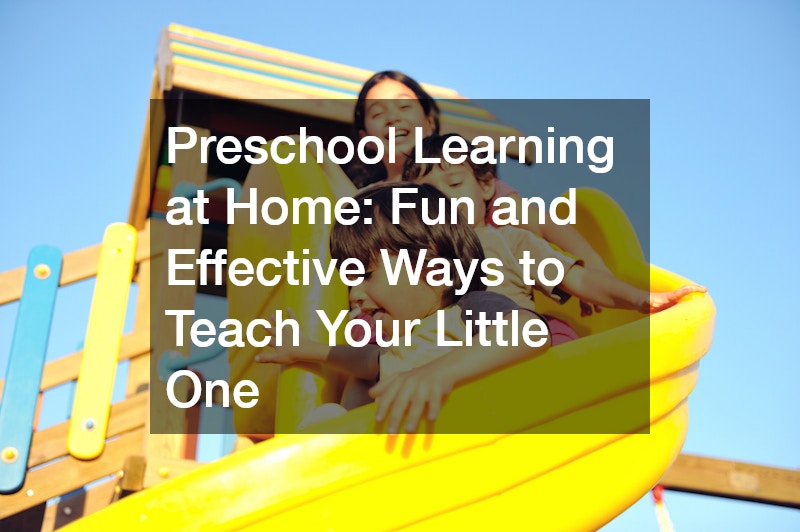Teaching your child at home can be an exciting and rewarding experience. Preschool learning at home allows parents to create a customized, flexible, and engaging environment that fosters early education while strengthening family bonds. With the right approach, resources, and dedication, your child can develop essential academic and social skills in a fun and nurturing setting.
1. What Are the Benefits of Preschool Learning at Home?
Home-based preschool learning offers numerous advantages that can set your child up for success in their future education.
1.1 Individualized Attention
One of the biggest benefits of preschool learning at home is the ability to provide one-on-one attention. Unlike traditional preschools, where teachers must divide their focus among multiple students, parents can tailor lessons to their child’s unique learning pace and style.
1.2 Flexible Learning Environment
A home learning environment allows for flexibility in scheduling and lesson planning. Parents can adjust the curriculum based on their child’s interests, energy levels, and daily routine, making learning a more enjoyable experience.
1.3 Strengthening Family Bonds
Spending quality time learning together can enhance family relationships. Activities such as reading stories, playing educational games, and engaging in hands-on projects promote positive interactions. In some cases, incorporating family therapy techniques, such as open communication and cooperative activities, can further support emotional and social development.
2. How Do I Set Up a Learning Space at Home?
Creating an effective learning environment at home requires careful consideration of space, organization, and minimal distractions.

2.1 Choosing the Right Location
Select a quiet, well-lit area that can be dedicated to learning activities. Ensure the space is comfortable, organized, and free from distractions. Regular carpet cleaning helps maintain a fresh and inviting learning environment, free from dust and allergens.
2.2 Essential Furniture and Supplies
A sturdy table, comfortable chairs, bookshelves, and storage bins for materials can create an effective preschool setup. Consider incorporating child-friendly furniture that supports independent learning.
2.3 Organizing Materials
Use labeled storage bins and shelves to keep educational materials easily accessible. This teaches children the importance of organization and responsibility.
2.4 Minimizing Distractions
While learning at home, distractions can be a challenge. If your learning space is near a pool cage, ensure it is childproofed and separated from the educational area to maintain focus.
3. What Subjects Should I Focus On?
Preschool learning at home provides the flexibility to introduce a wide variety of subjects that support your child’s cognitive, social, and creative development. While structured lessons are beneficial, it’s important to keep activities engaging, hands-on, and playful.
3.1 Language and Literacy
Language development is a cornerstone of preschool education. Strong literacy skills help children communicate effectively, recognize letters, and develop a love for reading.
- Letter Recognition and Phonics – Use flashcards, magnetic letters, or interactive songs to introduce the alphabet. Sound out words together and encourage your child to repeat them.
- Storytime and Read-Alouds – Reading books daily expands vocabulary and comprehension. Choose colorful picture books, interactive stories, and rhyming books to make reading fun.
- Speaking and Listening Skills – Encourage conversation by asking open-ended questions and allowing your child to express their thoughts. Role-playing and storytelling help develop confidence in speaking.
- Pre-Writing Skills – Before formal writing, children need to develop fine motor control. Activities like tracing, finger painting, and playing with clay strengthen hand muscles.
3.2 Basic Mathematics
Math for preschoolers should be hands-on and practical, allowing them to grasp numbers and basic concepts in a playful way.
- Counting and Number Recognition – Use everyday objects like toys, snacks, or buttons for counting practice. Singing counting songs also reinforces numbers.
- Shapes and Patterns – Introduce geometric shapes through puzzles, drawing, and shape-sorting games. Recognizing patterns strengthens logical thinking.
- Simple Addition and Subtraction – Use real-life scenarios, such as sharing snacks or playing with building blocks, to demonstrate basic math operations.
- Measurement and Comparison – Teach concepts of size, weight, and volume using common household items. Baking together, for example, is a great way to introduce measurement skills.
3.3 Science Exploration
Young children are naturally curious about the world, making science an exciting subject to explore at home.
- Nature Walks and Observations – Take your child outside to explore leaves, insects, clouds, and other natural elements. Ask questions to encourage observation skills.
- Simple Experiments – Hands-on activities like making a baking soda volcano, freezing and melting ice, or growing plants teach basic scientific principles.
- Weather and Seasons – Track the daily weather together and discuss how seasons change. A homemade weather chart can make this activity interactive.
- Animal and Plant Life – Read books and watch documentaries about animals and plants. Visit a local zoo, farm, or botanical garden for real-life learning.
3.4 Social Skills Development
Social-emotional learning is crucial for preschoolers, helping them understand emotions, interact with others, and develop empathy.
- Sharing and Taking Turns – Play cooperative games that require teamwork. Praise positive behavior to reinforce social skills.
- Expressing Emotions – Teach your child to name and express their feelings. Role-play different scenarios, such as handling frustration or making friends.
- Following Instructions – Start with simple, one-step directions and gradually increase complexity. Activities like Simon Says or obstacle courses help develop listening skills.
- Problem-Solving and Conflict Resolution – Encourage your child to think through problems rather than reacting emotionally. Guide them through steps to resolve conflicts with siblings or friends.
3.5 Creative Arts
Creativity helps children express themselves while improving fine motor skills, concentration, and cognitive flexibility.
- Drawing and Coloring – Provide crayons, markers, and paper to encourage freehand drawing. Coloring books can help with fine motor control.
- Music and Movement – Sing songs, dance to music, and play simple instruments like tambourines or xylophones. Music enhances memory and coordination.
- Crafting and DIY Projects – Use household items like cardboard, pasta, and cotton balls to create fun art projects. Seasonal crafts keep activities fresh and engaging.
- Pretend Play and Storytelling – Role-playing as different characters or acting out favorite stories enhances creativity and language skills.
By focusing on these subjects, you can create a rich and engaging preschool learning experience at home that fosters intellectual, social, and creative growth.
4. How Can I Make Learning Fun for My Child?
Keeping learning exciting ensures children remain engaged and motivated.

4.1 Interactive Games
Educational board games and digital games make learning fun.
4.2 Hands-On Activities
Crafts, sensory bins, and pretend play encourage hands-on engagement. If your child enjoys outdoor adventures, consider themed activities, such as a pretend golf cart rentals game where they “drive” to different learning stations.
4.3 Storytelling and Reading
Reading books together builds vocabulary and comprehension skills.
4.4 Outdoor Learning
Nature walks, scavenger hunts, and gardening introduce scientific concepts in an exciting way.
4.5 Incorporating Technology
Educational apps and videos can enhance interactive learning.
5. What Resources Are Available for Home-Based Preschool Education?
There are many tools available to support home learning.
- 5.1 Online Educational Platforms – Websites offer free and paid preschool curriculums.
- 5.2 Educational Apps – Interactive apps support reading, math, and problem-solving skills.
- 5.3 Printable Worksheets – Free worksheets reinforce key concepts.
- 5.4 Community Libraries – Access to books and educational programs.
- 5.5 Parenting Books and Guides – Helpful tips for teaching preschoolers at home.
6. How Can I Assess My Child’s Learning Progress?
Evaluating progress ensures children are developing key skills.
6.1 Observational Assessments
Monitor how well your child grasps new concepts through daily activities.
6.2 Portfolios and Projects
Keep a collection of artwork, worksheets, and projects to track progress.
6.3 Checklists and Milestones
A milestone checklist helps track growth in different areas. If concerns arise, a pediatric dentist may identify developmental delays through oral health assessments.
6.4 Regular Feedback Sessions
Encourage open discussions about learning experiences.
6.5 Professional Evaluations
If needed, an educator or acupuncture treatment specialist may provide insight into areas needing improvement.
7. How Do I Keep My Child Motivated?
Keeping your preschooler engaged in learning can be challenging, but with the right strategies, you can nurture their natural curiosity and enthusiasm.

7.1 Setting Achievable Goals
Young children thrive on success. Break down learning objectives into small, manageable tasks so they feel a sense of accomplishment. For example, instead of expecting your child to recognize all letters of the alphabet at once, focus on learning a few letters per week. Celebrate each milestone to build confidence.
7.2 Reward Systems
Positive reinforcement is a great way to encourage learning. Reward charts with stickers, verbal praise, and small treats (such as an extra story at bedtime or a special outing) can motivate children. However, rewards should be used sparingly to avoid making learning feel like a chore.
7.3 Encouraging Curiosity
Children are naturally curious, and nurturing that curiosity fosters a lifelong love of learning. Answer their questions with enthusiasm, encourage them to explore, and introduce new topics in exciting ways. If your child loves cars, incorporate a race cars theme into a lesson about speed, colors, or counting.
7.4 Building a Positive Learning Environment
A supportive and patient atmosphere helps children associate learning with fun rather than pressure. Avoid comparing your child to others and instead focus on their unique progress. Keep learning spaces colorful and inviting to stimulate interest.
7.5 Teaching Resilience and Patience
Mistakes are a natural part of learning. Teach your child that it’s okay to struggle and that persistence leads to improvement. Celebrate effort as much as results, and model patience when they face difficulties.
8. How Do I Balance Academic Learning with Play?
Play is a crucial part of a preschooler’s development and can be seamlessly integrated into their learning routine.
8.1 Understanding the Importance of Play
Play-based learning helps children develop problem-solving skills, creativity, and social abilities. A mix of structured activities (puzzles, games, and crafts) and free play (imaginative and outdoor play) ensures balanced growth. Even something as simple as building a mini fence with a local fence company play kit can teach concepts of construction, measurement, and teamwork.
8.2 Integrating Play into Lessons
Make lessons interactive by incorporating play. For example, if you’re teaching numbers, use toy cars or blocks for counting activities. Turn learning into a game with scavenger hunts, pretend store shopping, or storytelling sessions where they act out characters.
8.3 Unstructured Play Time
Allowing free, unstructured play fosters independence and creativity. Let your child explore their environment, build with blocks, or engage in pretend play. Running through a sprinkler on a hot day can be both a fun activity and an opportunity to discuss water cycles or temperature changes.
8.4 Social Play with Peers
One challenge of homeschooling preschoolers is limited social interaction. Arrange playdates, join local parent groups, or participate in library storytime sessions to help your child develop essential social skills.
8.5 Balancing Screen Time
While educational apps and videos can be helpful, limit screen time to ensure a balanced approach. Hands-on activities, outdoor play, and direct interactions should take precedence over digital learning.
9. What Are Some Challenges of Preschool Learning at Home?
Teaching your child at home comes with unique obstacles, but understanding them can help you find solutions.

9.1 Time Management
Balancing home learning with household responsibilities can be overwhelming. Create a daily schedule that includes designated learning times, breaks, and household tasks. Involve your child in small chores to teach responsibility.
9.2 Lack of Social Interaction
Since preschoolers learn a lot through social interactions, limited exposure to other children can be a concern. Address this by enrolling them in community programs, dance or art classes, or arranging regular playdates.
10. Can Home-Based Preschool Learning Support My Child’s Future Education?
Yes! Home-based learning helps build critical skills that prepare children for future schooling.
10.1 Building a Strong Foundation
Preschool learning at home provides early exposure to literacy, numeracy, and problem-solving skills. Children who begin learning in a comfortable environment often transition more easily into formal education.
10.2 Encouraging a Growth Mindset
Teaching children that intelligence and abilities grow with effort fosters a growth mindset. Instead of saying, “You’re so smart,” try, “You worked hard to figure that out!” This encourages resilience and a willingness to tackle challenges.
10.3 Developing Critical Thinking Skills
Encouraging children to ask questions, solve problems, and think independently builds critical thinking skills. Simple experiments, like testing which materials float in water, can develop early scientific thinking.
10.4 Fostering Emotional Intelligence
Emotional intelligence is just as important as academic knowledge. Teaching children to recognize and express their emotions, handle frustration, and show empathy helps them navigate social situations successfully. Discussions about feelings, role-playing, and storytelling are great ways to build these skills.
10.5 Transitioning to Formal Schooling
A well-structured home learning experience makes the transition to kindergarten smoother. Teaching essential self-help skills—such as following instructions, tidying up, and recognizing personal space—ensures children feel confident when entering a structured classroom setting.
Parents can also consider first aid training, like infant CPR, to ensure they’re prepared for emergencies and can create a safe learning environment at home.
Preschool learning at home is an enriching experience that allows children to develop at their own pace while building a strong educational foundation. By making learning interactive, incorporating play, and addressing challenges proactively, you can create a positive environment that fosters curiosity and confidence in your little one. Whether through storytelling, hands-on projects, or outdoor exploration, your efforts will have a lasting impact on your child’s love for learning.



